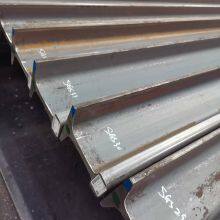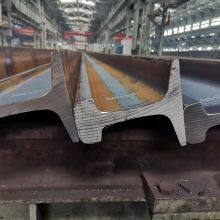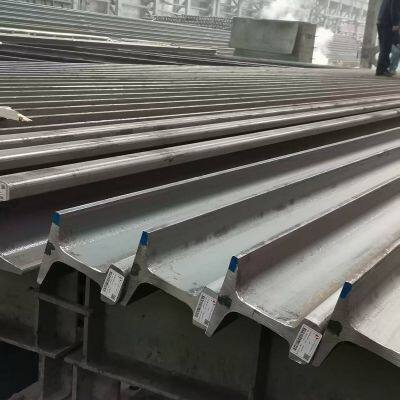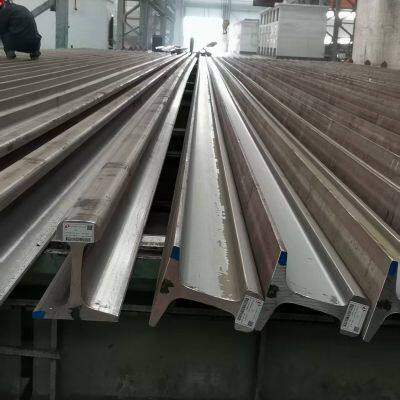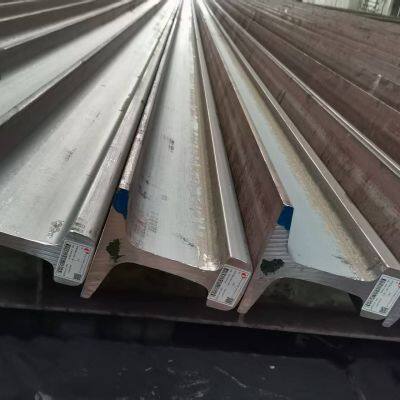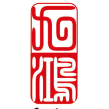Baotou Steel Heavy Rail 43kg/m 50kg/m 60kg/m 75kg/m UIC54 UIC60 Steel Rail U71Mn U75V 900A High Speed Train Rail
Rails are the main components of railway tracks. Its function lies in guiding the wheels of locomotives and vehicles forward, bearing the huge pressure of the wheels and transmitting it to the sleepers. The rails must provide the wheels with a continuous, smooth and least resistant rolling surface. In electrified railways or automatic block sections, rails can also be used as track circuits.
Domestic
In China, steel rails can be classified into three types based on their approximate weight in kilograms per meter: crane rails (hoist rails), heavy rails and light rails.
Crane rails are divided into four types: QU120,QU100,QU80, and QU70. The material is generally manganese steel, and the heaviest single weight is QU120, which can reach 118kg/m.
② Heavy rail. According to the steel type used, they can be classified as: common manganese-containing steel rails, copper-containing common carbon steel rails, high-silicon copper-containing steel rails, copper rails, manganese rails, silicon rails, etc. There are mainly three types: 38, 43 and 50 kilograms. In addition, there are 45kg rails for a few lines, and 60kg rails have been planned for use on lines with large passenger volumes and high vehicle speeds. GB2585-81 stipulates the technical conditions for 38-50kg/m steel rails in China. Their dimensions and codes are shown in Table 6-7-10.
In 2007, China promulgated the new standard GB 2585-2007. Besides 38-50kg/m, heavy rails of 60kg/m and 75kg/m were newly added.
Abroad
Each country in the world has its own standards for the production of steel rails, and the classification methods also vary.
For example: British standard :BS series (including 90A,80A,75A,75R,60A, etc.)
German standard :DIN series crane rails.
International Union of Railways :UIC series.
American standard :ASCE series.
Japanese standard :JIS series.
③ Light rail. The variety is stipulated in standard (5) of "8". There are mainly different rail types such as 9, 12, 15, 22, and 30kg/m, and their cross-sectional dimensions and rail type categories are as shown in 6-7-11. The technical conditions are detailed in Standard (3) in "8".
Light rail is also divided into two types: national standards (GB) and ministry standards (YB standards of the Ministry of Metallurgy). The above-mentioned are several models of GB. The models of YB include :8, 18, 24kg/m, etc.
(2) Manufacturing and Application.
The rails are rolled from carbon killed steel smelted in open hearth furnaces and oxygen converters. Its purpose is to withstand the operating pressure and impact load of locomotives and vehicles.
Rail type
The type of rail is expressed in kilograms per meter of rail mass. The steel rails used in China's railways include several types such as 75kg/m, 60kg/m, 50kg/m, 43kg/m and 38kg/m.
The cross-sectional shape of the rail adopts an I-shaped section with the best bending resistance performance, consisting of three parts: the rail head, the rail waist and the rail bottom. To enable the rail to better withstand forces from all directions and ensure the necessary strength conditions, the rail should have sufficient height, with adequate area and height for its head and bottom, and the waist and bottom should not be too thin.
Among the various types of rails mentioned above, 38kg/m rails have now ceased production. 60kg/m and 50kg/m rails are laid on the main lines, while 43kg/m rails are generally laid on station lines and dedicated lines. For heavy-haul railways and particularly busy sections of railways, 75kg/m steel rails will be laid.
In addition, to meet the requirements of structures such as turnouts, extra-large Bridges and seamless tracks, China's railways have also adopted special section (I-shaped rails that are asymmetrical to the central axis). AT present, the most widely used type is the low special section steel rail, which is abbreviated as AT rail.
The length of the folded rail
The standard lengths of steel rails in our country are 12.5m and 25.0m. Extra-heavy-duty and heavy-duty rails adopt standard-length steel rails of 25.0m, while other types of rails can use standard-length steel rails ranging from 12.5m to 25.0m.
The "Interim Technical Conditions for 60kg/m Steel Rails of 250km/h Passenger Dedicated Lines" stipulates that the standard gauge length of steel rails for 250km/h passenger dedicated lines (including freight transportation) is 100m.
There are three types of curve shortening rail lengths that are 40, 80, and 120mm shorter than the 12.5m standard rail, and three types that are 40, 80, and 160mm shorter than the 25.0m standard rail.

Send Inquiry to This Supplier
You May Also Like
-
Baotou Steel 16 Inch Seamless Steel Pipe X52 Line PipeNegotiableMOQ: 30 Metric Tons
-
Baotou Steel Seamless Structure Pipe EN10210 S355J0H S355JRH S355J2H S355NH Structural Steel PipesNegotiableMOQ: 30 Metric Tons
-
Bao Steel 15CrMoG 12Cr1MoVG P11 T11 P22 T22 Cr-Mo Alloy Seamless Steel Pipes Hot Rolled Alloy Boiler PipesNegotiableMOQ: 30 Metric Tons
-
Baotou Steel 406.4mm X52 Seamless Steel Pipe Underground Oil and Gas PipelineNegotiableMOQ: 30 Metric Tons
-
Baotou Steel X42 Gr.B DN 400 DN400 Seamless Steel PipeNegotiableMOQ: 30 Metric Tons
-
Baogang Group Baotou Iron and Steel Group BISG Seamless Steel PipeNegotiableMOQ: 30 Metric Tons
-
Baotou Iron and Steel Group BISG API 5CT LC SC BTC Thread L80 J55 Casing 13 3/8 Inch Seamless Steel CasingNegotiableMOQ: 30 Metric Tons
-
Baotou Steel GB/T 5310 Seamless Steel Pipes 12Cr1MoVG 15CrMoG HP High Pressure Boiler PipesNegotiableMOQ: 30 Metric Tons
-
Seamless Steel PipeNegotiableMOQ: 30 Metric Tons
-
X60 Line PipeNegotiableMOQ: 30 Metric Tons





